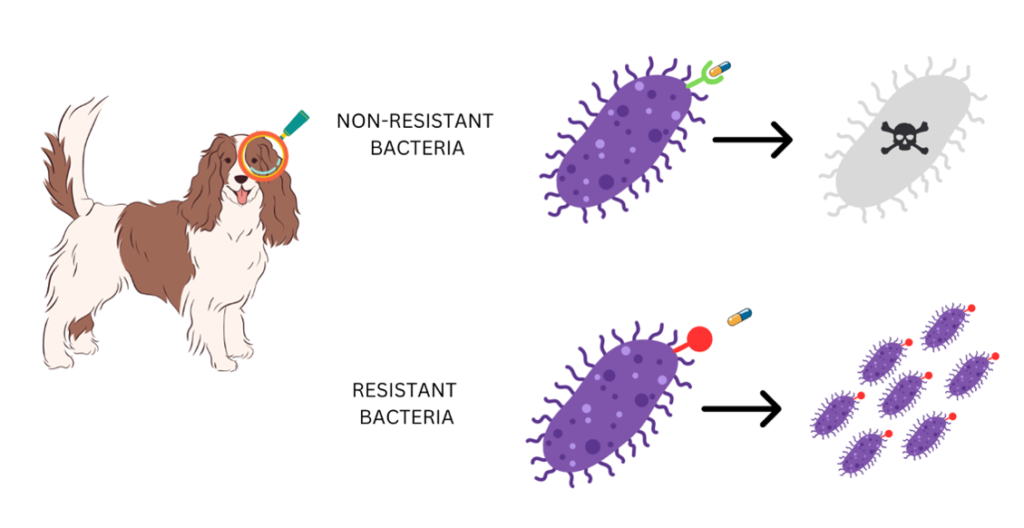Antibiotic Resistance
Antibiotic resistance means that the bacteria present in your pet’s infection are no longer susceptible to an antibiotic. It is important to remember that it is not your pet that is resistant to the antibiotic, it is the bacteria that are resistant. The bacteria have developed ways to avoid or fight the antibiotic. If your pet has an antibiotic-resistant infection, the infection will not go away following a full course of the antibiotic. Bacterial infections can be resistant to one type of antibiotic, or several types – what we call ‘multi-drug resistance’.
This image shows how a single bacteria with antibiotic resistance is able to continue to replicate even with treatment, creating an infection of resistant bacteria

What causes antibiotic resistance?
Misuse of antibiotics leads to antibiotic resistance. Here are some of the examples of antibiotic misuse:
- Not completing the full antibiotic course.
- Taking antibiotics for infections that are not caused by bacteria e.g. viral infections.
- Not taking the recommended dose of antibiotic.
- Using an antibiotic against bacteria that are not normally susceptible to it.
How do bacteria become resistant to antibiotics?
Bacteria become resistant through genetic mutation. Genetic mutation results in new proteins being formed that protect the bacteria from the antibiotic. Bacteria reproduce by cloning themselves, so a single bacterium with a resistant gene can quickly cause a resistant infection.
By misusing antibiotics, we increase the chance of resistant bacteria surviving. This means your pet now has a bacterial infection that can’t be treated with the antibiotics that would normally work.
Even more scarily, pets can pass these bacteria on to us, and the bacteria can pass resistant genes between them, meaning pets act as a reservoir of resistance genes that can cause serious problems for human health.
What is antibiotic stewardship?
Antibiotic stewardship is the effort made to use antibiotics responsibly. Vets and owners can help to reduce antibiotic resistance by promoting good antibiotic stewardship. Antibiotic stewardship benefits human and animal health by protecting the efficacy of antibiotics we have available.
What can be done if my pet has an antibiotic-resistant infection?
Your vet may perform a culture and sensitivity test to double-check if any antibiotics will work against your pet’s infection. There are hundreds of antibiotics available, but some are protected so that they can only be used in the case of a resistant bacterial infection. Resistant infections may take longer to treat, which will also make treatment more expensive. Even if your pet’s resistant infection clears up, your pet is more susceptible to resistant infections in the future. Preventing them from getting infections in general will be vital to avoid this.
- Why Do Dogs Sleep So Much? A Vet Explains What’s Normal (and What’s Not) - March 27, 2025
- 10 Signs Your Dog Needs Probiotics – Vet Explains When to Supplement - March 14, 2025
- The dog gut microbiome explained (by a vet) - March 10, 2025

